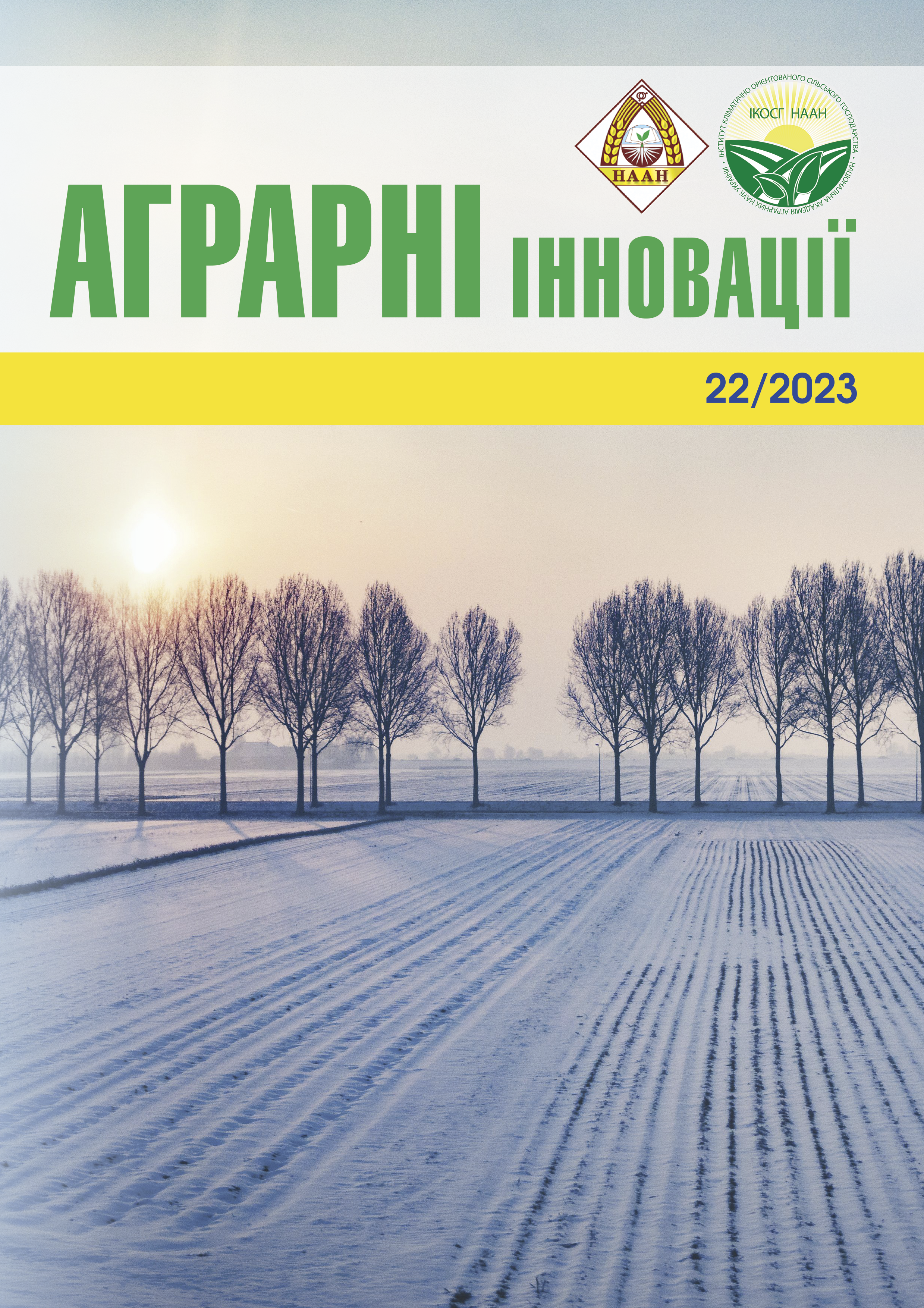WHITE ROT SCLEROTINIA SCLEROTIORUM – A THREAT TO THE GROWING OF OIL CROPS IN THE CONDITIONS OF FAILURE TO COMPLY WITH CROP ROTATION
Abstract
The article presents the results of research on the study of harmfulness and prerequisites for the development of white rot (sclerotiniosis) Sclerotinia Sclerotiorum. The goal is to study the prerequisites for the spread of white rot (sclerotiniosis) Sclerotinia Sclerotiorum in Ukraine Research materials and methodology. The research was carried out by studying statistical and literary sources on the issues of growing oil crops and the features of the development of sclerotiniosis. The results. The white rot (slcrotiniosis) is a disease that is harmful to oil crops (sunflower, rapeseed, soybean) grown in Ukraine has been established. Annual crop losses can amount to 20-35%, and in some cases they amounted to 50-80%. Since the source of infection of plants with white rot is the soil and plant remains, the key place in the fight against it belongs to crop rotation. In recent years in Ukraine, due to oversaturation of crop rotation with crops susceptible to sclerotiniosis (sunflower, soybean, rape), all prerequisites for its mass development are created. So, in particular in 2022, the total share of sunflower, rapeseed and soybeans in the structure of sown areas on a national scale was 33.8%. In some regions, in particular Kirovohrad and Sumy regions, the specified indicator exceeds 40%. In all regions of Ukraine, an excess of the recommended indicators of crop rotation saturation with it was noted. Thus, with the recommended parameters for the Polissia zone of 0.5%, its actual share is 6.9-16.0%, for the Forest-Steppe and Steppe zones, with a normative value of no more than 9 and 15%, the actual indicators are at the level of 5.8- 29.2 and 27.8-37.8%. Only in Zakarpattia, Chernivtsi and Lviv regions, the share of sunflower in the structure of cultivated areas is at a scientifically justified level. The share of rapeseed and soybean in the structure of crops is within the recommended indicators for the agroclimatic zones of Ukraine. However, in combination with sunflower and rape, there is a serious threat to the cultivation of oil crops due to the danger of the spread of sclerotiniosis. Conclusions. Thus, on the basis of the analysis of literary and statistical sources, it was established that due to the neglect of knowledge about the biological features of white rot (sclerotiniosis) and non-observance of scientifically based rotation of agricultural crops, prerequisites are created for the spread of this disease in Ukraine. This, in turn, poses a threat to the successful cultivation of sunflower, soybean and rape due to the massive development of Sclerotinia Sclerotiorum in these agrophytocenoses. Therefore, an important element of the cultivation of oil crops is the implementation of constant phytomonitoring and control of the spread of sclerotiniosis in sunflower, soybean and rapeseed crops, followed by the adoption of effective measures to avoid the spread of the harmful factor.
References
galuzeva programa virobnictvo ta efektivne vikoristannyaso%D1%97taproduktiv%D1%97%D1%97-pererobki-vukra%D1%97ni-na-2015-2020-roki (Дата звернення: 03.01.2024).
2. Занько Т. Ринок олійних: виробництво зростає, ціна падає. Агробізнес сьогодні. 2014. URL: http://www.agro-business.com.ua/. (Дата звернення: 03.01.2024).
3. Зовнішня торгівля. Державна служба статистики України. URL: https://ukrstat.gov.ua/operativ/operativ2022/zd/e_iovt/arh_iovt2022.htm. (Дата звернення: 10.01.2024)
4. Кузнєцов О. М. Сучасний стан та перспективи розвитку галузі олійних культур в Україні з урахуванням світового досвіду. Економіка АПК. 2002. № 7.
С. 24–25.
5. Марков І. Л., Башта О. В., Гентош Д. Т., Глим’язний В. А., Дерменко О. П., Черненко Є. П. Фітопатологія : підручник. Київ. 2017. 548 с.
6. Побережна А. А. Формування світового і вітчизняного ринків олійних культур. Економіка АПК. 1999. № 8. С. 91–96.
7. Постанова Кабінету Міністрів України № 164 від 11 лютого 2010 року «Про затвердження нормативів оптимального співвідношення культур у сівозмінах в різних природно-сільськогосподарських регіонах». URL: https://zakon.rada.gov.ua/laws/show/164-2010-%D0%BF#Text. (Дата звернення: 03.01.2024).
8. Рослинництво України. Державна служба статистики України. URL: https://www.ukrstat.gov.ua/druk/publicat/kat_u/2022/zb/05/zb_rosl_2021.pdf. (Дата звернення: 03.01.2024).
9. Чехова І. В., Чехов С. А. Основні тенденції розвитку ринку олійних культур в Україні. Продуктивність агропромислового виробництва. економічні науки. 2014. № 25. С. 71-78. URL: http://nbuv.gov.ua/UJRN/Pav_2014_25_14. (Дата звернення: 03.01.2024).
10. Alkooranee J.T., Aledan T.R., Ali A.K., Lu G., Zhang X., Wu J., Fu C., Li M. Detecting the hormonal pathways in oilseed rape behind induced systemic resistance by Trichoderma harzianum TH12 to Sclerotinia sclerotiorum. PLoS ONE. 2017, 12. URL: https://journals.plos.org/plosone/article?id=10.1371/journal.
pone.0168850 (Дата звернення: 03.01.2024).
11. Boland G.J., Hall R. Index of plant hosts of Sclerotinia sclerotiorum. Can. J. Plant Pathol. 1994. 16. РР. 93–108.
12. Derbyshire M. C., Denton-Giles M. The control of sclerotinia stem rot on oilseed rape (Brassica napus): Current practices and future opportunities. Plant Pathol. 2016. 65. РР. 859–877.
13. Ekins M.G., Aitken E.A.B., Goulter K.C. Carpogenic germination of Sclerotinia minor and potential distribution in Australia. Australas. Plant Pathol. 2002.
31. РР. 259–265.
14. Harveson, R. M. Sclerotinia diseases of sunflower in Nebraska. NebGuide G2107, University of Nebraska Cooperative Extension, Lincoln, NE, USA. 2011. URL: http://extensionpublications.unl.edu/assets/pdf/g2107.pdf(Дата звернення: 03.01.2024).
15. Heffer Link, V., Johnson, K.B. White Mold. Plant Health Instructor. 2007. URL: https://www.apsnet.org/edcenter/disandpath/fungalasco/pdlessons/Pages/WhiteMold.aspx. (Дата звернення: 03.01.2024).
16. Markell S., Harveson R., Block C., Gulya T. Sunflower Disease Diagnostic Series. North Dakota State University Cooperative Extension Service, Fargo, ND,
USA. 2015. Publication. PP. 1727.
17. Mathew F., Harveson R., Block C., Gulya T., Ryley M., Thompson S., Markell S. Sclerotinia sclerotiorum diseases of sunflower (white mold). Plant Health Instructor. 2020. URL: https://www.apsnet.org/edcenter/disandpath/fungalasco/pdlessons/Pages/PHI-P-2023-08-0007.aspx. (Дата звернення: 03.01.2024).
18. Melvin D. Bolton, Bart P. H. J. Thomma, Berlin D. Nelson Sclerotinia sclerotiorum (Lib.) de Bary: biology and molecular traits of a cosmopolitan pathogen.
Molecular Plant Pathology. 2006. 7(1). 1–16. URL: https://bsppjournals.onlinelibrary.wiley.com/doi/full/10.1111/j.13643703.2005.00316.x (Дата звернення: 03.01.2024).
19. Smolinska U., Kowalska B. Biological control of the soil-borne fungal pathogen Sclerotinia sclerotiorum – A review. J. Plant Pathol. 2018. 100. РР. 1–12.






